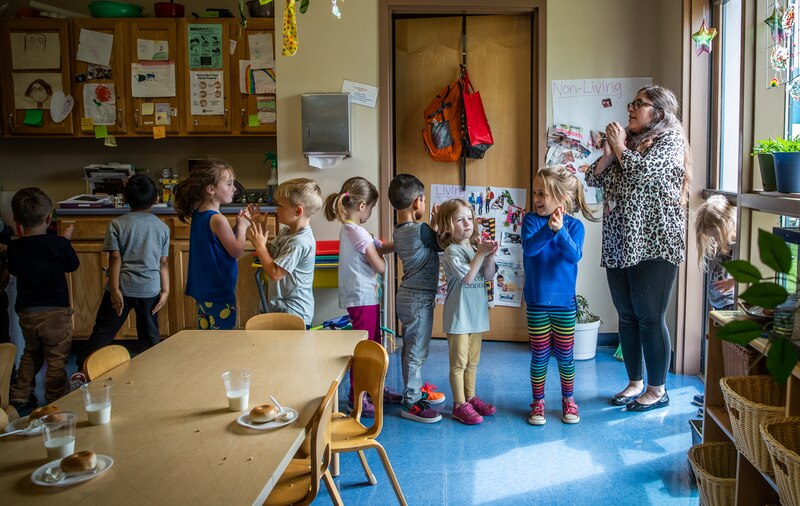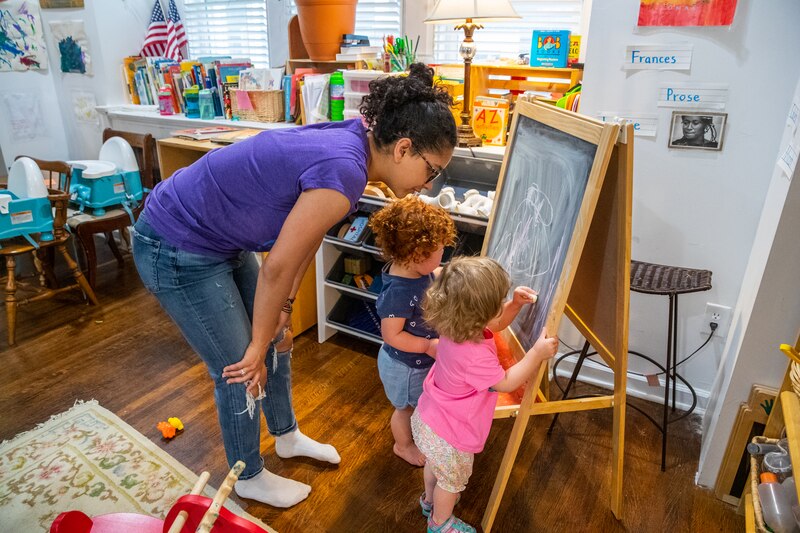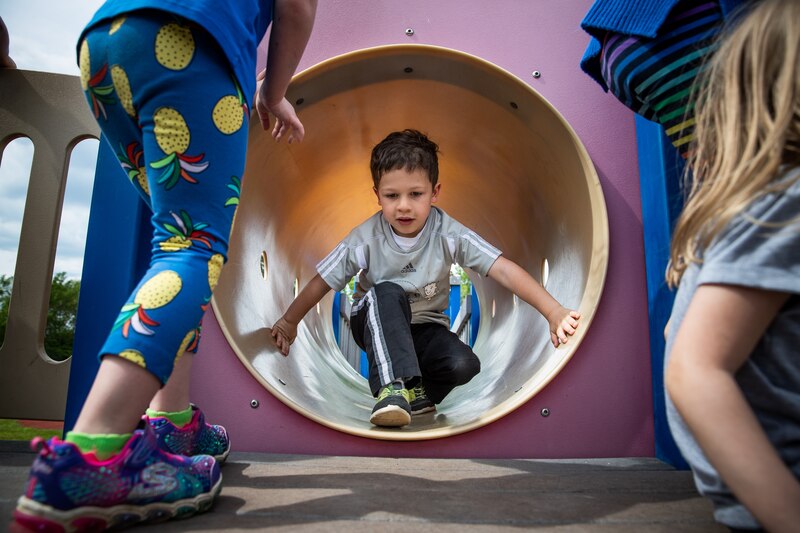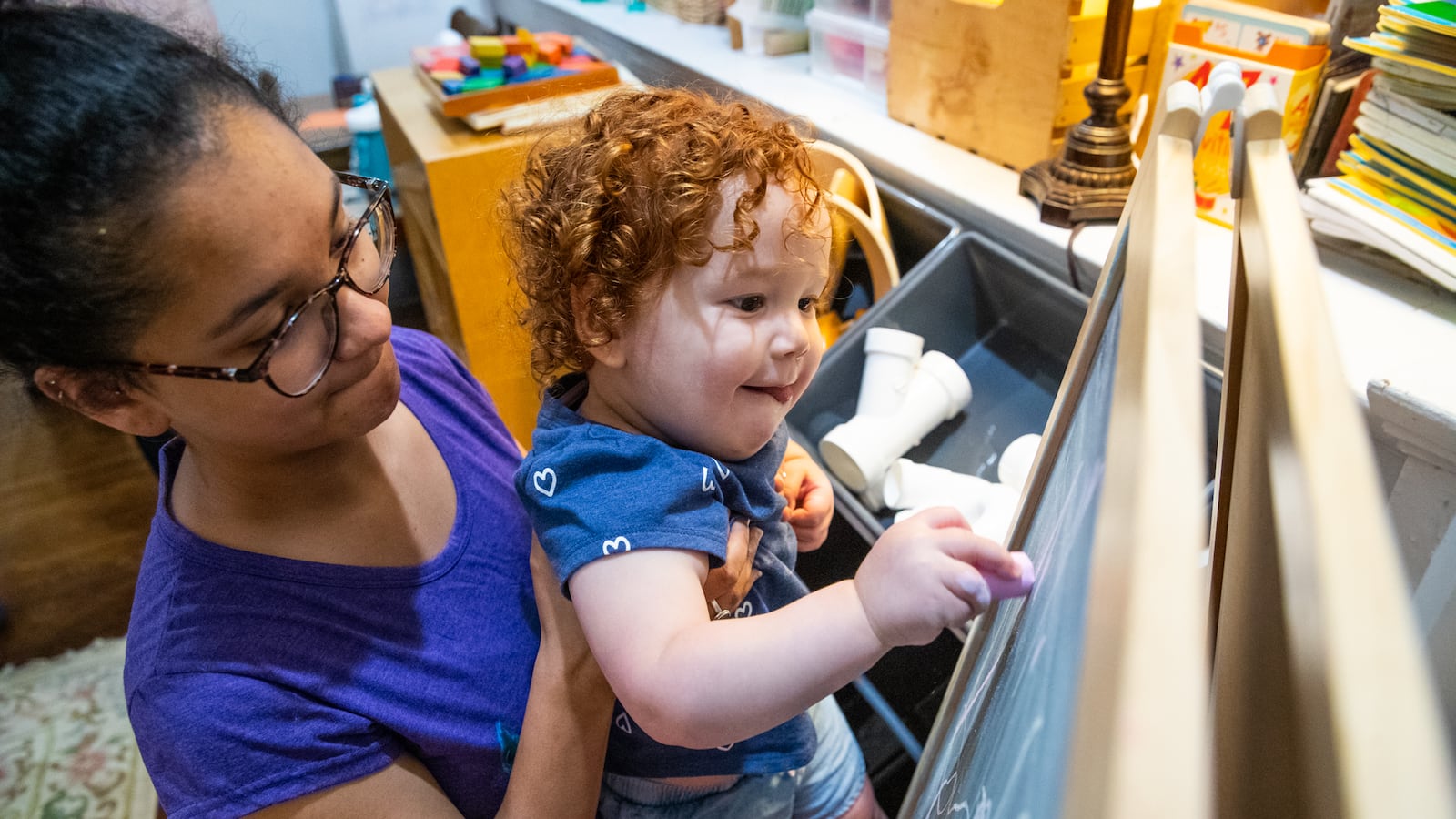Editor’s note: This story was produced by the IndyStar. Please do not republish without their permission.
Step into Elizabeth Dobrow’s classroom at IU Health Day Early Learning center and odds are Devorius Price will greet you at the door. The 5-year-old is full of excitement about the class’ caterpillars, some of which have already formed their chrysalises.
“They’ll turn into a butterfly!” Devorius will tell you, while pulling you by the hand over to see the fuzzy bugs and shiny shells.
Around the class, small clusters of 4- and 5-year-old preschoolers are engaged in different activities. Some are making paper crafts with their teacher. Another few are playing with blocks. One is asleep on a cot.
Devorius and several others are bopping around the noisy, busy room.
It’s barely controlled chaos.
But the running around, the babbling, the play — the chaos — is highly important. Because what you don’t see when you just step in the classroom — what you can’t see while Devorius is pulling you over to look at the caterpillars or when he’s chasing you on the playground in a seemingly never-ending game of tag — is what’s going on inside their heads.
These children are at the peak of brain development. They’re growing, making connections, learning. From birth until about age 8, kids’ brains are sponges, soaking up everything around them. By age 5, when kids start formal schooling, their brains are 90% developed.
“Really, those first three years of life are the most significant years for brain development,” said Erin Kissling, vice president of research and policy initiatives for Early Learning Indiana. Early Learning is an advocate for high-quality early learning and care statewide. It also operates nine Day Early Learning centers around Indianapolis.
“But the brain grows really quickly through the first eight years of life,” Kissling said. “So, we have this sweet spot in that zero to five space that, in our state, we haven’t paid that much attention to until very recently. And at this point, we’re really focused just on the 4-year-olds. Some would say we are even missing the most vital years of brain development, but we do have to start somewhere, right?”
Indiana is starting small — very small. Its state-funded pre-kindergarten program, On My Way Pre-K, is income-based and serves only 10% of the estimated 4-year-olds who would qualify.
Possibly because the state lacks a robust public pre-K program, there aren’t enough high-quality providers to accommodate all Hoosier 4-year-olds. For families who don’t qualify for assistance, the cost can be prohibitive — and that’s only if they even have high-quality providers in their communities. Some still don’t.

The different types of play
It’s hard to understate the importance of this time period for not just kids and the development of their brains — but for the people that they’ll become.
Devin Price said he’s noticed big changes in his son, Devorius, over the two years he’s been attending preschool at Day Early Learning.
“He can play with people now,” Devin said. “He’s got a control problem. That’s better since we’ve been here.”
Self-regulation is an important skill that develops in the preschool years.
Kids also develop persistence, an understanding of how rules work and nearly countless other skills – both academic and social emotional.
And the best way for this development to happen is through play, said Sarah Parks-Reese, pre-K expansion specialist for the Indiana Department of Education and the Family and Social Services Agency. The play is not just random, though. In high-quality early learning centers it is purposeful.
There’s dramatic play, where kids learn creative expression — skills that build toward important kindergarten standards such as identifying characters, plots and settings in stories. There’s exploratory play, where young minds start to develop initiative and self-direction. Outside on the playground, in that game of tag, they’re building critical gross motor skills. And they’re building other kinds of skills — social ones, such as conflict resolution and compromise.
When one kid tries to crawl up the slide, while others are trying to fly down it, they have to work it out among themselves. They’re learning that both can’t happen at the same time, so they must negotiate who goes first.
All of this play is underpinned by the Early Learning Foundations — a development framework that sets expectations for what children should achieve from birth to age 5 to be ready for future success in school and beyond. They include goals for development and learning in traditional subjects such as English and math — like being able to count backward from 10 — but also covers social emotional milestones like building relationships and self-regulation.
It looks like play. It is play. But it’s important, valuable play.
“We don’t want children in pre-K to be sitting at a desk, doing worksheets and things like that,” Parks-Reese said. “We really want the curriculum to be play-based.”
That’s why high-quality preschools have robust requirements for the kinds of classroom environments they provide to students.

How Indiana rates preschools
All preschool is not created equal. Studies show that high-quality experiences have the greatest impact on young kids — preparing them for kindergarten and, possibly, improving outcomes for them and their families later in life. At least one study found benefits extend even to the children of kids who attended high-quality preschool.
So, in order to invest in high-quality experiences, it’s imperative to first understand what those look like and set criteria that help providers achieve a high-quality experience and then for families (and the state, as it starts to fund pre-K) recognize it.
Indiana’s system is called Paths to Quality. It’s a rating system that scores centers as a Level 1, 2, 3 or 4, with Level 4 the highest. Participation in the system is voluntary, so there are undoubtedly some providers doing a good job but not participating the system for one reason or another.
Level 1 centers ensure that minimum health and safety requirements are met.
An enriching learning environment comes next. To be rated a Level 2 or higher on Paths to Quality, providers must have 10 different learning centers — think of them as themed stations — available to kids, for everything from art, music and drama to reading, writing and math.
In most classes, those look as you’d expect: an easel with oversized paper, crayons and paints. Music centers might have hand drums or plastic xylophones. A corner stacked with building blocks.
Classes are also required to have a nature or science center, where you might find a terrarium full of caterpillars.
Level 2 centers are also required to offer outdoor time and differentiated programming for infants and toddlers.
Levels 3 and 4 build on the environment created in Level 2 centers. They must include a planned curriculum that is aligned to the stages of child development. Levels 3 and 4 also set higher standards for the professional development of the center director and staff.
To reach Level 4, centers must achieve accreditation from a nationally recognized body.
Indiana has about 4,500 registered childcare providers. Just 10% of those are rated a Level 4. One-fourth of providers are rated a Level 3; another quarter are at Level 1. Fewer than 200 centers statewide are a Level 2.
More than one-third of providers don’t participate in Paths to Quality at all, so they have no rating.
The system is designed to encourage providers to move along the Paths to Quality, incentivizing them to achieve higher levels. Though it’s only a small program right now, only Level 3 and 4 providers are eligible for state funds through On My Way Pre-K.
This ensures that the state is only paying for the kinds of experiences that research shows really pays off for kids. A high-quality preschool experience can boost low-income kids, who usually enter kindergarten behind their peers, and establish an educational foundation equal that of their peers.
“Children were showing like 15 months worth of gains in the nine-month period of attending a high quality pre-K,” Parks-Reese said. “So 15 months in nine months made them much more prepared for kindergarten, which in the long term, made them more prepared for first grade, second grade, third grade, so on and so forth, right?
“So, it’s really building that foundation and getting them ready for lifelong learning.”

Inside a Level 4-rated preschool
Providers rated Level 3 or higher — what it takes to be eligible to take state funds — are easy enough to find in urban centers such as Indianapolis. Marion County has more than 16 percent of the state’s high-quality providers. There are three counties in the state — Warren, Sullivan and Starke — without a single provider rated a Level 3 or 4 and another nine counties with just one high-quality provider.
Three counties in the state have just one provider total.
Even in Indianapolis where there are plenty of traditional, commercial preschool settings, many still have waiting lists. High-quality programs can also be found in other settings: churches, homes, community centers, schools.
Cynthia Randolph-Vaughn has transformed the first floor of her home into a Level 4-rated preschool called Cindy’s Center For Young Learners. There’s a water table on her front porch — recommended for sensory play. Inside, there’s an inviting fort for reading. Draped with blankets and piled with cushions, it was supposed to be for one kid at a time, Randolph-Vaughn said, but it’s next to impossible to keep them out of it.
“It was supposed to be for just one kid to relax,” she said, “but when one goes in, they all go in.”
Her walls are covered in artwork and educational posters. In the backroom, there are plastic bags with seedlings growing inside hanging on the sliding glass doors.
She’s got nine kids right now — ranging in age from four months old to nearly 5 years old — but has a list of other interested families. She’s looking to expand as soon as this summer.
Eventually, she may move her operations into a commercial center to accommodate demand because, even if the state hasn’t caught up, many parents have.
And they are looking for high-quality preschool experiences.
MOVING 4WARD is a collaborative reporting project by IndyStar and Chalkbeat Indiana. The project examines the current state of Early Childhood Education in Indiana with an emphasis on how best to prepare our state’s 4-year-olds (hence the project title) for kindergarten and beyond. Expect stories to take a critical look at preschool programs, issues of access to those programs, the debate over the value of taxpayer-funded universal preschool, what lessons can be learned from other states, and – perhaps most importantly – what you, as a parent, need to know to make informed decisions about choosing your child’s preschool.
Call IndyStar education reporter Arika Herron at 317-201-5620 or email her at Arika.Herron@indystar.com. Follow her on Twitter: @ArikaHerron.

